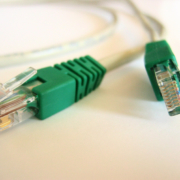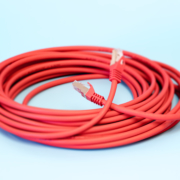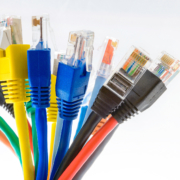Cat5e Cable FAQ
What is Cat5e Cable?
Category 5e cable is a data cable that is classified as a twisted pair data cable. The cable is constructed of 8 separate cores which are split into 4 pairs of colours. The pairs are twisted together (twisted pair). The pairs within a Cat5e cable are solid and white, solid combination. Lastly, the colours are Blue, Orange, Brown and Green.
What is the maximum Cat5e Speed?
Cat5e cables Provide a bandwidth of 100Mhz. However, the cables are available with up to 350MHz capabilities.
The maximum capability of a Cat5e’s gigabit ethernet speed is 1 GBps. The previous (Cat5) had a limit of 100Mb transmission. It’s important to know, Cat5e is not specified or recommended for 10 Gigabit ethernet. Cat6a is the minimum category recommended for 10 Gigabit Ethernet.
Cat5 vs Cat5e
Since 2001, Cat5e has been the standard data cable. Prior to this advancement Cat5 was the go-to data cable. Cat 5 was limited to 100MB transmission. These cables are no longer manufactured, and they are rarely seen, even in old buildings.
How Much is Cat5e Cabling? (Price per Point)
The overall quote for your structured cabling project can be affected by many factors. For instance, building type, number of outlets, ease of access. Price per point is only used as a rough estimation.
Cat5e Price Per Point is £35.00 – £50.00
Cat5e vs Cat6
Cat6 is the next category of data cabling after cat5e. The main difference between the two cables is the bandwidth. Cat6 has a bandwidth of 250Mhz in comparison to 100Mhz produced by Cat5e. At the standard 90m permanent link distance, both cables are only able to transmit 1 Gigabit ethernet speeds. However, Cat6 is capable of 10 Gigabit up to 55mm.
The easiest way to differentiate the two cables is by looking at the sheath of the cable. Data cables are marked with code numbers and other digits, the cable will also have writing confirming Cat5e or Cat6. Furthermore, unlike Cat5e, Cat6 cables have a plastic central divider placed between the 4 pairs. However, this does depend on the manufactures, it’s not always the 100% the case.
Are Cat5e Cables backwards compatible?
All data cable categories from Cat5e to Cat8 have an element of a connector called an RJ45. This is for the module or jack (female end) and the plug (male end). As a result, all categories are backwards compatible with other data cable categories. Equally important, in any data cabling installation the overall link will only be as good as its weakest part. For instance, a Cat5e module using a Cat6 cable will perform at Cat5e level.
Can you use Cat6 connectors on Cat5e cable?
The short answer is yes. However, you would be using a more expensive connector and only achieve the lower performance standard. Additionally, using a Cat5e connector on a Cat6 cable will also result in a loss of performance.
Cat5e UTP vs FTP
UTP stands for Unshielded Twisted Pair. FTP stands for Foil Twisted Pair. FTP and UTP cables are exactly the same in terms of performance, both cables are still capable of 100Mhz and 1 Gigabit transmission. The difference between the 2 cables is that FTP cables have an additional foil shield surrounding the inner cores. This addition provides protection from external noise.
What is armoured cat5e cable?
Armoured cables are data cables with an additional layer of protection against outside damage. Armoured cables are also referred to as steel wired armoured (SWA). The cables are constructed of strands of steel wire surrounding the inner cable. The steel wire offers additional protection against external factors such as, crushing or being cut during digging. The performance of the cable remains the same as a standard cable.
What is External Cat5e?
External Cat5e is a cable with a PE sheath. The Polyethylene (PE) sheath provides additional protection from external environmental factors such as moisture and temperature. Unlike an armoured cable, this cable doesn’t offer additional structural protection. The cable is the same as an internal Cat5e.
How Far can you run cat5e cables for CCTV?
With structured cabling there is a standard data cabling specification that applies to all technology. Regardless of the technology the cable will run the same over standardised cabling. The maximum distance of 90 metres for Cat5e applies for CCTV’s, computers, Wi-Fi, and any other technology. The distance of 90m allows for 5m patch lead at each end. Lastly, a 100m direct link is also available.
Can I Run HDMI over Cat5e?
Yes, Cat5e has the ability to transfer HDMI signals. This is done via a transmitter and a receiver plugged into each end. However, the recommended data cable is a minimum of Cat6 or Cat6a, due to their larger bandwidth and speed capability these cables will be better suited for transferring HDMI signals.
How do you test Cat5e cables?
A continuity tester can be used to test cat5e cables. The tester has 8 lights which will confirm if the 8 cores (4pairs) have been correctly terminated. Its important to realise, these testers do not give feedback about the transmission capabilities of the cable. Additionally, there is no feedback about the quality of installation and terminations of the ends.
Another test is a cable certification tester for example, a Fluke DSX. These types of testers show a chart that will highlight the performance of the cable. Furthermore, these tests will also highlight any effects of faulty termination or poor installation. Lastly, a Fluke DSX tester will summarise if the cable can transmit as intended.
Can you run PoE over Cat5e?
Cat5e is capable of running PoE. However, with the advancement of technology, the devices powered by PoE are requiring greater power supplies. For this reason, Cat6a will be better suited for all your devices. In addition, using a Cat5e cables with modern devices will increase the noise interference of the cable.





